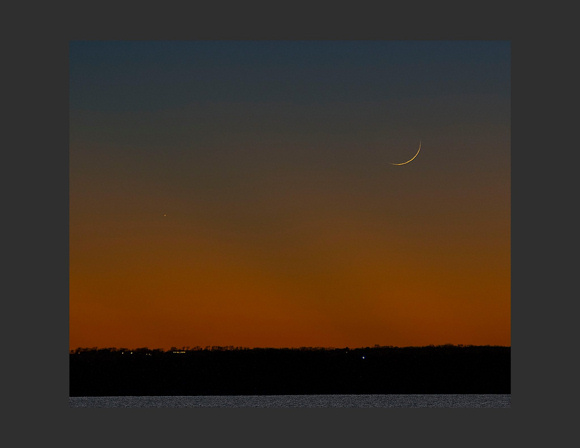Tonight – November 13, 2014 – shortly after sunset, look for the young and slender waxing crescent moon. From mid-northern latitudes, its illuminated portion will point in the direction of the setting sun – and also toward the planet Saturn, which resides on our sky’s dome between the sunset and moon on this date. From our latitudes, Saturn will follow the sun below the horizon before nightfall, setting about an hour after sunset. Thus Saturn will be extremely hard to see in the glare of evening twilight.

From mid-Southern Hemisphere latitudes: You might glimpse Saturn, too, if you have an unobstructed horizon and clear sky on this date. For you, Saturn’s setting time after sunset is a few minutes later … but not enough to make much difference. Notice that, if you’re at mid-latitudes in the Southern Hemisphere, the illuminated part of the crescent moon points to the left, not the right. Sweep with your binoculars near the crescent moon to find Saturn.
No matter where you are on Earth, you’ll most likely need binoculars for any chance of catching Saturn in the November evening sky. Catch the moon first, and let it guide you to the planet.
While you’re out there, be sure to look for earthshine on the waxing crescent moon itself. It’s always a beautiful sight.
And so it’ll be a great night to stand under a darkening sky … Saturn or no Saturn.
Saturn is the lone visible planet in the evening sky at present. It will pass behind the sun from Earth on November 30, and thus move officially into our morning sky. You’ll need to wait a few weeks for Earth to speed along in its smaller, faster orbit around the sun. In a few weeks, we’ll turn a corner, so to speak, in the vast space of our solar system, bringing Saturn into view once more before sunrise. You should spot it again before sunrise before the year ends.

Bottom line: So long, Saturn! Only the sharpest-eyed observers on Earth on the evening of November 13, 2015 will catch this world near the sunset. On this date, the bright portion of the waxing crescent moon points to Saturn. Binoculars will help you spot this world, as it leaves our evening sky.
Astronomy events, star parties, festivals, workshops for September-December, 2015











